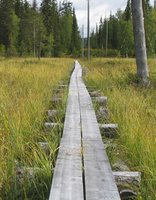Thursday, August 17, 2006
Miten kettu voi Värriössä - How is Red fox doing in Varrio Nature Reserve?
 Värriön tutkimusasemalle pitkospuita kävelevä huomaa tuon tuostakin pitkospuilla ketun jätöksiä ( - jotka jäävät kuitenkin yleensä kuvaamatta). Kesällä ketusta ei juuri muuta havaintoa saakaan.
Värriön tutkimusasemalle pitkospuita kävelevä huomaa tuon tuostakin pitkospuilla ketun jätöksiä ( - jotka jäävät kuitenkin yleensä kuvaamatta). Kesällä ketusta ei juuri muuta havaintoa saakaan.Miten Värriön kettukanta lienee muuttunut luonnonpuiston perustamista seuranneiden rauhoitusten tultua voimaan? Tähänkin saamme parhaan vastauksen talvisin hiihdettäviltä lumilinjoilta.
Pitkällä lumilinjalla laskettiin ketunjäljet vuosina 1968-2006 (39 vuotta) yhteensä 2682 kertaa. Talvikausittain havaittujen jälkien määrä näyttäisi olevan hienoisessa nousussa. Vuosien välinen vaihtelu on kuitenkin niin suuri, että nousulla ei ole tilastotieteen antamaa merkitsevyyttä (nousun todennäköisyystaso on alle vaadittavat 95 prosenttia; se on "vain" 89 prosenttia).
 When walking to Varrio Research Station through the wooden track we often see droppings of Red fox (Vulpes vulpes) on the track (- for some reason the droppings are not so favorite targets to photographer). In the summer time this is almost the only means to get information about foxes.
When walking to Varrio Research Station through the wooden track we often see droppings of Red fox (Vulpes vulpes) on the track (- for some reason the droppings are not so favorite targets to photographer). In the summer time this is almost the only means to get information about foxes.How have the Red fox populations developed after 1981 when the rules of Strict Nature Reserve became effective in Varrio? The snowlines that are observed by skiing in wintertime give best answer also to this question.
In the long snowline we have counted Red fox tracks altogether 2682 times during the season 1967/68 to 2005/06 (39 years). Based on the annual data (in the graph) it looks like the Red fox population is in a slight rise. The rise, however, is not statistically significant. The probability level for the rise is 89 per cent only (when the significance level is 95 %).